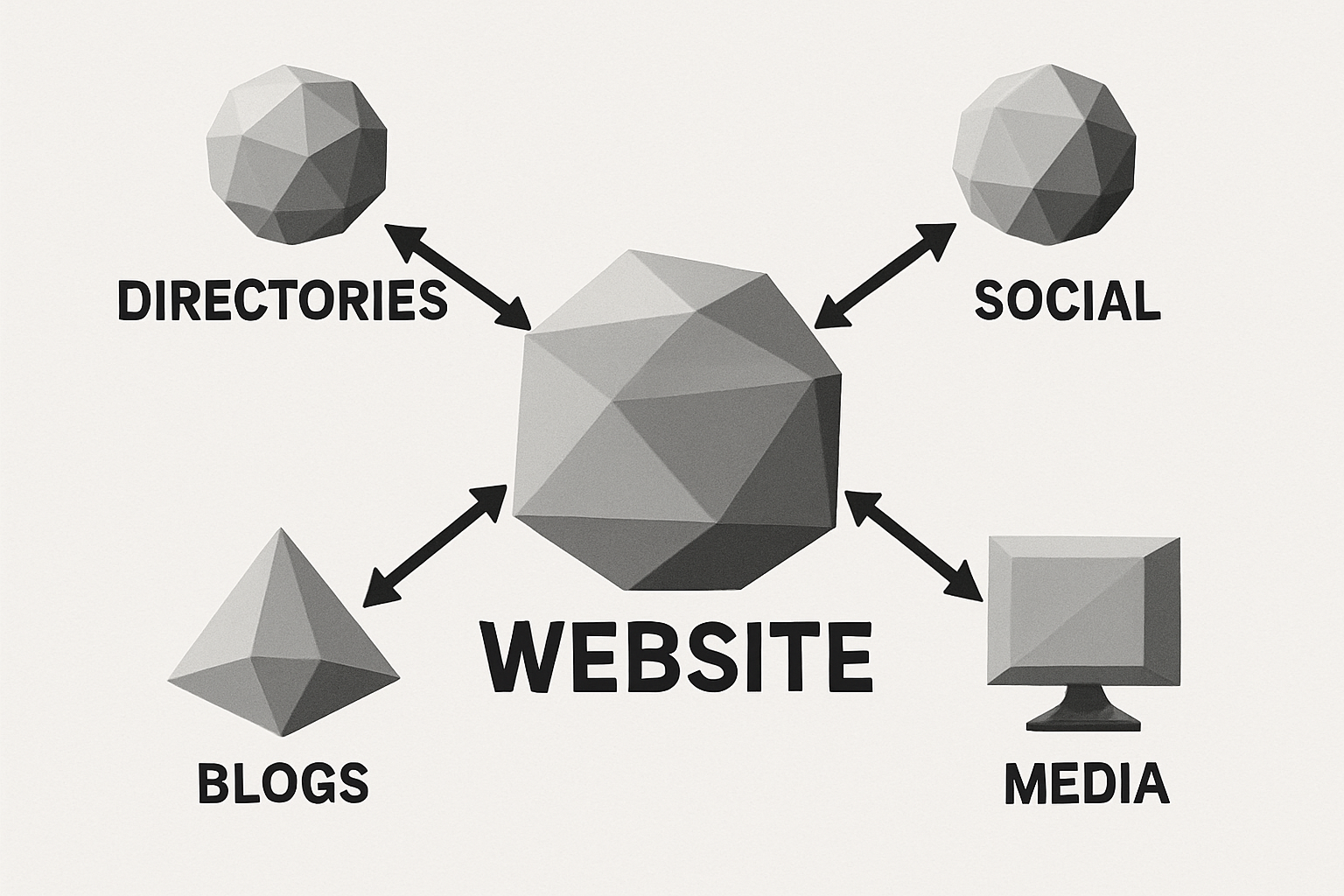Referral traffic is rapidly becoming a cornerstone of digital marketing strategies for 2025. Recent data shows its share of total website visitors has surged from 3% to over 10%.
By tapping into referral traffic, businesses diversify their audience beyond search engines. This approach helps reduce reliance on Google while building resilience against unpredictable algorithm updates.
Why does this matter? Referral traffic often brings higher conversion rates, valuable backlinks for stronger SEO, and a boost in brand credibility.
In this guide, you'll discover seven proven strategies to boost referral traffic in 2025, complete with practical examples and expert advice.
Understanding Referral Traffic: Definition, Value, and 2025 Trends
In the evolving landscape of digital marketing, understanding referral traffic is crucial for anyone aiming to future-proof their website growth. Let’s break down what referral traffic is, why it’s gaining momentum, the trends shaping 2025, and which sources are making the biggest impact.

What Is Referral Traffic?
Referral traffic refers to visitors who land on your website by clicking a link from another external site, rather than arriving via a search engine or typing your URL directly. This type of traffic is distinct from organic, paid, or direct sources.
Typical sources of referral traffic include:
- Blogs and guest posts
- News websites and aggregators
- Online directories and review sites
- Social media platforms and niche forums
For example, imagine a reader clicks a link in your guest post on an industry blog and arrives at your homepage. That’s referral traffic in action. According to WordStream’s explanation and examples, understanding these distinctions is essential for tracking and optimizing your web presence.
Why Referral Traffic Matters in 2025
Referral traffic is taking center stage in 2025 as its share of website visits climbs steadily. Recent data shows that referral traffic increased from 3% to over 10% for average websites, highlighting its growing significance.
Visitors from referral links often display higher intent and engagement, since they are actively choosing to click based on interest or recommendation. This translates into better conversion rates and longer site visits. Equally important, referral traffic brings quality backlinks, boosting SEO rankings and domain authority. Businesses that tap into diverse referral sources are less vulnerable to search engine algorithm changes, ensuring more stable and resilient website performance.
Key Referral Traffic Trends for 2025
Several key trends are shaping the future of referral traffic. Social media platforms and niche online communities are becoming primary discovery channels, especially for younger users. The landscape of online directories and review sites is expanding, offering more opportunities for visibility.
Brands are investing heavily in partnerships, content syndication, and collaborative marketing to maximize referral traffic. Data-driven outreach and relationship building are also on the rise, helping companies secure more valuable mentions. For instance, younger audiences now search for businesses directly on social platforms, bypassing traditional search engines and boosting referral opportunities.
Common Referral Traffic Sources (with Data)
Referral traffic flows from a variety of sources, each offering unique benefits. The most prominent channels include:
- Social media platforms: Facebook, LinkedIn, TikTok, Instagram
- Guest blogging and content collaborations
- Online directories: Yelp, Angi, BBB
- Press releases and news aggregators
- Influencer and partner websites
Recent statistics show social media is rapidly increasing its share of referral traffic, particularly among younger demographics. Guest posting and directory listings remain reliable sources, while earned media and influencer partnerships can deliver spikes in visits and quality backlinks. Competitor case studies illustrate that a diversified referral traffic strategy pays off with higher engagement and conversion rates.
7 Proven Strategies to Boost Referral Traffic in 2025
Referral traffic is shaping up to be a game-changer for digital marketers in 2025. As more brands look beyond traditional channels, these seven proven strategies can help you attract high-quality visitors, boost conversions, and future-proof your website traffic mix. In fact, according to recent findings, 15% of website traffic comes from referrals, highlighting the strategic value of optimizing for referral traffic sources.

1. Optimize and Expand Directory Listings
Getting your business listed on reputable online directories is a cornerstone for driving referral traffic. Start by ensuring your profiles are present and consistent across platforms like Yelp, Google Business Profile, Angi, and BBB, plus any niche directories relevant to your industry.
Accuracy is key. Double-check your business name, address, phone number, and website URL for consistency. This not only improves your chances of appearing in directory searches but also builds trust with both users and search engines.
To stand out, enrich your listings with photos, videos, and detailed service descriptions. Encourage customers to leave reviews and respond promptly to feedback. These elements make your listings more engaging and credible, directly impacting referral traffic.
Regularly audit your directory presence using tools like Listings Grader. Identify and fix duplicate or outdated entries to maintain a clean digital footprint. Set a schedule to update listings with new promotions, seasonal offers, or operational changes.
Consider this: a local service business that optimized over 20 directory listings saw a steady increase in referral traffic and higher conversion rates from directory visitors. For many local businesses, directories contribute a significant portion of overall referral traffic, making this step critical for sustained growth.
Quick Directory Listing Checklist:
- Claim and verify all relevant listings
- Use high-quality images and videos
- Keep contact info and hours updated
- Solicit and manage customer reviews
- Monitor and resolve duplicates
By making directory optimization a routine part of your marketing, you lay a strong foundation for capturing ongoing referral traffic from multiple trusted sources.
2. Leverage Guest Posting and Content Partnerships
Guest posting remains one of the most effective ways to generate referral traffic while building authority in your niche. Start by researching industry blogs, news sites, and partner platforms that accept guest contributions and align with your audience.
Craft personalized pitches with topic ideas tailored to each publication. Focus on providing unique insights, actionable tips, or fresh industry perspectives. When your content gets published, include contextual backlinks within the article or in your author bio to drive referral traffic back to your site.
Building long-term relationships with editors and site owners can lead to recurring opportunities. Consider collaborating on series, interviews, or co-authored posts for even greater impact.
Track the performance of each guest post using analytics. Look for spikes in referral traffic, engagement metrics, and conversions. Prioritize high-performing partnerships and refine your outreach strategy accordingly.
For example, a SaaS company that consistently published guest posts on niche tech blogs reported a steady climb in referral traffic and an uptick in qualified leads. The key is emphasizing quality over quantity—avoid spammy link schemes that could harm your reputation.
Best Practices for Guest Posting:
- Target authoritative, relevant sites
- Personalize every pitch
- Provide real value and original research
- Include natural, contextual backlinks
- Monitor referral traffic from each partnership
Strategic guest posting not only boosts referral traffic but also enhances your brand’s visibility and credibility in the industry.
3. Create and Distribute Link-Worthy Content
Producing standout content is essential for attracting organic referral traffic. Focus on creating resources that others in your industry want to reference—think original research, industry reports, infographics, and case studies.
Unique data-driven content is particularly effective. When you publish a compelling infographic or a report packed with fresh statistics, it naturally earns backlinks from journalists, bloggers, and influencers. These high-quality backlinks drive referral traffic and strengthen your SEO profile.
Promote your content through targeted outreach. Reach out to relevant websites, industry publications, and thought leaders, pitching your resource as a valuable asset for their audience. The more widely your content is shared, the more referral traffic you’ll generate.
Consider incorporating interactive elements or visual storytelling to increase shareability. For instance, an infographic that goes viral can earn you hundreds of backlinks and a surge in referral traffic from major media outlets.
Types of Link-Worthy Content:
| Content Type | Referral Impact | Example Use Case |
|---|---|---|
| Infographics | High | Viral industry trends |
| Case Studies | Medium-High | Solution-driven storytelling |
| Research Reports | High | Original data analysis |
Remember, the more unique and insightful your content, the more likely it is to become a referral traffic magnet.
4. Harness the Power of Social Media for Referral Growth
Social media has evolved into a powerful engine for referral traffic in 2025. To capitalize, share your website content across all relevant platforms—Facebook, LinkedIn, TikTok, and Instagram—with strong calls to action.
Get involved in niche groups and online communities, such as LinkedIn Groups or Reddit threads. Offering valuable insights and sharing resources in these spaces can spark meaningful referral traffic from highly engaged audiences.
Collaborate with influencers and micro-influencers to amplify your reach. Co-create content, participate in shoutouts, or launch joint campaigns to tap into new networks. Use platform-specific features—think LinkedIn Articles, Instagram Stories, or Facebook Events—to showcase your brand and drive referral traffic.
Monitor analytics closely to identify which social platforms and content types deliver the best referral traffic. Double down on what’s working and iterate on your approach as trends evolve.
For B2B brands, publishing thought leadership pieces on LinkedIn Pulse or participating in industry Twitter chats can result in a steady stream of high-quality referral traffic. Social media’s influence continues to grow, especially among younger audiences seeking brands outside traditional search engines.
5. Launch Strategic Press Releases and Earned Media Campaigns
Press releases and earned media are powerful tools for generating both immediate and long-term referral traffic. Identify newsworthy moments—product launches, partnerships, milestones—and craft compelling press releases to share with relevant media outlets and newswires.
Optimize your press releases by embedding backlinks to your website and including rich multimedia elements like images or videos. Target industry publications, local news sites, and online aggregators to maximize coverage and referral traffic potential.
After distribution, follow up with journalists and editors to secure feature stories or interviews. These earned media placements often come with high-authority backlinks, sending quality referral traffic to your site and boosting your SEO.
A startup, for example, saw a significant spike in referral traffic and domain authority after announcing a major product launch through a coordinated press release campaign. The initial surge is often followed by lasting SEO value as coverage is syndicated.
Keep in mind: press releases work best when you have genuinely newsworthy content. Don’t overuse them, and always track referral traffic performance to measure ROI.
6. Build Partnerships and Collaborations for Mutual Promotion
Strategic partnerships are a win-win for expanding your referral traffic sources. Connect with complementary brands to co-host webinars, swap guest posts, or cross-promote each other’s products.
Arrange for newsletter mentions, resource page links, or joint social media campaigns. Joint events—like virtual summits, challenges, or giveaways—can introduce your brand to entirely new audiences, driving referral traffic and potential sales.
Clear attribution is crucial. Use UTM parameters and analytics to track which partnership activities are sending the most referral traffic. This data helps you optimize future collaborations for even better results.
Take the example of two e-commerce brands that cross-promoted products in their email newsletters. Both saw a measurable increase in referral traffic and conversions, illustrating the power of well-aligned partnerships.
Best Practices for Collaborations:
- Vet partners for audience fit and reputation
- Define clear goals and roles
- Focus on win-win value
- Track all referral traffic sources
By investing in the right partnerships, you can unlock new streams of referral traffic and strengthen your brand’s reach.
7. Engage in Community Marketing and Niche Forums
Community-driven marketing is a goldmine for targeted referral traffic. Become an active member in industry-specific forums, Q&A sites like Quora or Stack Overflow, and niche online communities relevant to your business.
Provide thoughtful answers, share expertise, and contribute genuinely before promoting your content. When appropriate, include links back to your site to guide interested users and drive referral traffic.
Monitor trending topics and participate early in discussions for maximum visibility. Building credibility in these communities pays off with sustained referral traffic and higher engagement rates.
For instance, a marketer who regularly answered questions in a specialized subreddit consistently attracted high-quality referral traffic to their website. The key is authenticity—focus on helping, not just self-promotion.
Community Marketing Tips:
- Prioritize value over promotion
- Build relationships before sharing links
- Stay active and consistent
- Track referral traffic from each forum
Community-based referral traffic is often highly engaged and more likely to convert, making it a smart investment for brands looking to diversify their traffic sources.
Measuring and Optimizing Referral Traffic Performance
Understanding how to measure and optimize referral traffic is crucial for maximizing your digital marketing ROI. By using the right tools and following a data-driven approach, you can turn referral traffic into a sustainable growth engine for your website.

Tracking Referral Traffic: Tools and Metrics
To effectively track referral traffic, use analytics tools like Google Analytics to monitor where your visitors are coming from. Set up UTM parameters on your links to identify specific campaigns and sources. Focus on key metrics such as sessions, bounce rate, conversion rate, and average session duration from each referral source.
A simple table can help summarize what to track:
| Metric | Why It Matters |
|---|---|
| Sessions | Volume of referral visitors |
| Bounce Rate | Engagement from referral traffic |
| Conversion Rate | Quality of referred leads |
| Session Duration | Visitor interest level |
For a deeper dive on how SEO and website traffic sources—including referrals—interact, see SEO and website traffic insights.
Analyzing Referral Quality and ROI
Not all referral traffic is created equal. It’s important to analyze the quality of your sources by comparing engagement metrics and conversion rates. High-value referral traffic will show strong behavior signals: lower bounce rates, longer sessions, and higher conversions.
Use analytics filters to exclude bot and spam traffic, ensuring your data reflects real users. By regularly auditing your sources, you can spot which referral partners deliver the best ROI. This ongoing analysis will help you direct efforts toward the most profitable channels and protect your brand’s reputation.
Continuous Improvement: Testing and Iteration
Optimizing referral traffic performance is an ongoing process. Regularly A/B test your landing pages, CTAs, and content formats to see what resonates best with referred visitors. Try experimenting with new referral sources, outreach strategies, or partnership types.
Create a feedback loop: review results, gather insights, and adjust your tactics as needed. For example, you might find that tweaking your guest post strategy or updating directory profiles boosts referral conversions by a significant margin. Consistent testing ensures your referral traffic strategy evolves with audience preferences.
Avoiding Referral Traffic Pitfalls
While building referral traffic, avoid shortcuts like black-hat link-building, paid link schemes, or low-quality partnerships. These tactics can lead to toxic backlinks and even harm your SEO. Always vet your partners and ensure all listings are reputable.
Monitor your analytics for signs of referral spam or sudden drops in quality. If you detect suspicious sources, use tools like Google’s Disavow Links to protect your site. For more on safe backlink strategies, review the Building quality backlinks guide. Careful monitoring and a focus on quality will keep your referral traffic healthy and effective.
Action Plan: Implementing Your Referral Traffic Strategy for 2025
Ready to put your referral traffic plan into action? This step-by-step strategy will help you set clear goals, organize your workflow, assign the right roles, and adapt as new trends emerge. Let’s break it down into manageable steps for success.

Setting Goals and KPIs
Start by defining specific objectives for your referral traffic strategy. Outline what success looks like for your business. Do you want to increase referral traffic volume, boost conversions from referred visitors, or secure a certain number of high-quality backlinks?
Set SMART (Specific, Measurable, Achievable, Relevant, Time-bound) goals, such as “increase referral traffic by 25% in Q1 2025.” Align these goals with your broader marketing and business objectives. For more actionable tips, check out How to increase website traffic to complement your referral tactics.
Track key performance indicators (KPIs) like referral sessions, conversion rates, and average session duration. Clear goals and metrics keep your efforts focused and measurable.
Building a Referral Traffic Calendar and Workflow
Consistency is key for driving referral traffic. Create a calendar outlining regular outreach, content creation, and partnership activities. Schedule monthly guest posts, quarterly directory updates, and timely press releases.
Use project management tools like Trello, Asana, or Monday.com to assign tasks, set deadlines, and monitor progress. This ensures everyone knows their responsibilities and nothing falls through the cracks.
A sample workflow might look like this:
- Week 1: Identify new guest post opportunities
- Week 2: Update directory listings
- Week 3: Launch a press release
- Week 4: Analyze referral traffic results
Sticking to a structured schedule will help you build momentum over time.
Resource Allocation and Team Roles
Effective referral traffic growth requires the right team and resources. Assign clear roles for content creation, outreach, analytics, and partnership management. For small teams, one person might wear multiple hats, while larger organizations can delegate tasks more specifically.
Consider outsourcing specialized tasks like press release writing or using automation tools for directory management. This can save time and boost efficiency.
For example, you might divide responsibilities as follows:
- Content manager: oversees blog posts and guest articles
- Outreach specialist: builds relationships and secures backlinks
- Analyst: tracks referral traffic data and reports on KPIs
Defining roles ensures nothing gets overlooked and everyone works toward the same goals.
Monitoring Progress and Adapting to Trends
Regularly review your analytics to see which referral traffic sources are delivering results. Monitor KPIs monthly or quarterly, and adjust your tactics as needed. Stay updated on new platforms and best practices to keep your strategy fresh.
With digital marketing evolving rapidly, it’s crucial to pivot when needed. For instance, AI-driven traffic to retail websites jumped 12x between July 2024 and February 2025, highlighting the importance of adapting to new sources and technologies.
If you notice social referrals outperforming directory links, shift more resources to social campaigns. This flexible approach ensures your referral traffic continues to grow, no matter how the landscape changes.
Now that you’ve seen how referral traffic can unlock new audiences and strengthen your brand’s resilience, why not take the next step? If you’re ready to put these seven strategies into action but want to save time and get even better results, let AI handle the heavy lifting. With RankPill, you can automate content creation, spot the best keyword opportunities, and keep your referral strategy on track—all in one place. Let’s make 2025 your best year for traffic growth yet. Get Started